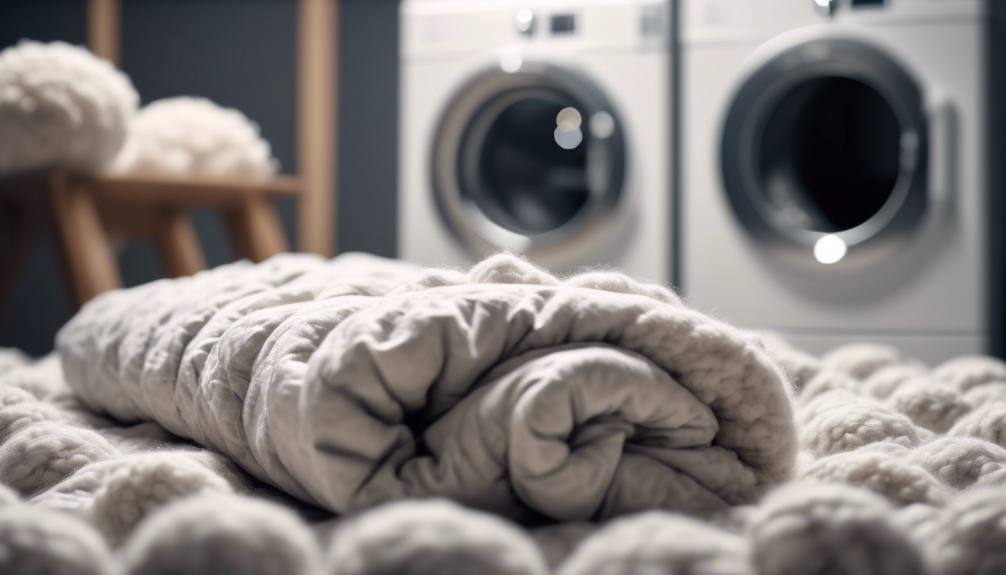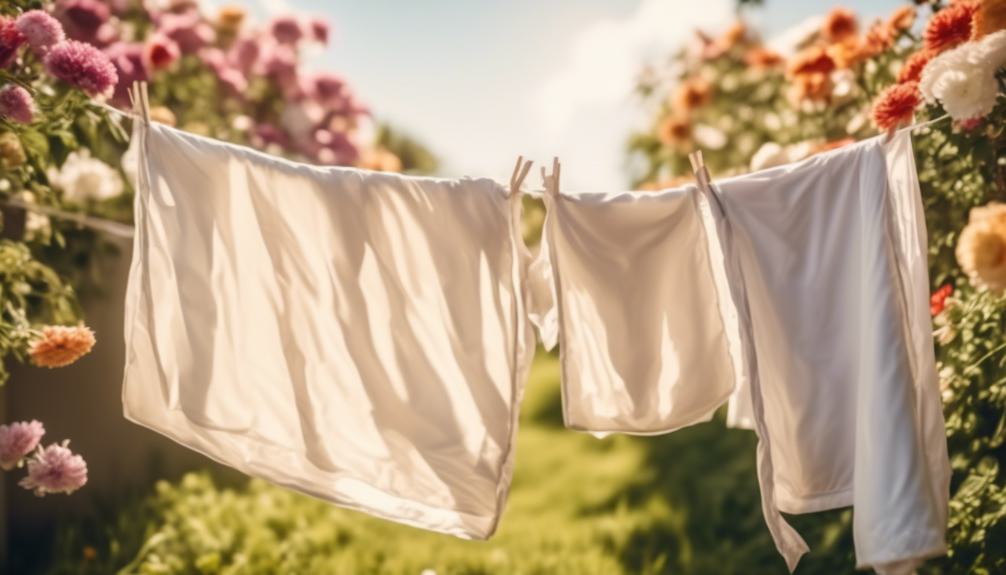How Long Does Duvet Take to Dry? Drying Time Explained
Have you ever waited for a duvet to dry, feeling like it’s taking as long as watching paint dry? The drying time for a duvet can seem like a mystery, but understanding the factors that affect it can help you manage your expectations and optimize the process.
From the type of material to the size of the duvet, there are several key elements that come into play.
So, how long does it really take for a duvet to dry? Let’s unravel this mystery and shed some light on the drying time of your beloved bedding.
Key Takeaways
- The drying time of a duvet can be affected by factors such as the type of dryer used, the capacity and specific settings of the dryer, the material of the duvet, the level of dampness in the duvet after washing, and the use of dryer balls.
- Proper preparation before placing the duvet in the dryer, selecting the right cycle and heat setting based on care instructions, using dryer balls to keep the duvet fluffy, periodically shaking and redistributing the filling during drying, and ensuring the tumble dryer is only two-thirds full are important drying techniques for duvets.
- To speed up the drying process, it is recommended to use tennis or lacrosse balls, or dryer balls, to prevent clumping, pause the drying process to shake and redistribute the filling, fill the tumble dryer only two-thirds full, and select a low or medium heat setting.
- The average drying times for different duvet types are as follows: feather duvets take 2-3 hours in a vented dryer, synthetic fiber duvets take 1-2 hours to dry completely in a vented dryer, feather duvets take 4-6 hours to air dry, and synthetic fiber duvets take 2-4 hours to air dry. It is important to understand these drying times for effective planning.
Factors Affecting Drying Time

The type of dryer you use significantly affects the drying time of your duvet. The capacity and the specific settings of the dryer play a crucial role in determining how long it takes for your duvet to dry thoroughly. Factors such as the material of the duvet, whether it’s feather or synthetic, also impact the drying process.
Additionally, the level of dampness in the duvet after the washing machine cycle can necessitate additional drying cycles. To expedite the drying process, consider using wool dryer balls or tennis balls to aid in the fluffing and drying of the duvet.
Ensure that you use low or medium heat and a gentle laundry detergent when drying your duvet, and consider employing extra rinse and spin cycles to remove excess moisture, thus reducing the overall drying time.
Drying Techniques for Duvets

To optimize the drying time of your duvet, it’s crucial to employ specific techniques that complement the factors affecting the drying process, such as the type of dryer and the material of the duvet. Here are essential drying techniques to consider:
- Proper Preparation: Before placing the duvet in the dryer, ensure it’s adequately prepared, such as untangling any clumps and ensuring it’s evenly distributed within the dryer.
- Selecting the Right Cycle and Heat Setting: Always adhere to the care instructions provided for the duvet and select an appropriate cycle and heat setting to prevent damage and maintain its quality.
- Use of Dryer Balls: To ensure the duvet stays fluffy, consider using tennis or lacrosse balls, or specifically designed dryer balls, and periodically shake and redistribute the filling during the drying process.
Tips to Speed Up Drying Process

Speed up drying time for your duvet by implementing these effective tips and techniques.
- Use tennis or lacrosse balls, or dryer balls, to prevent clumping during the drying cycle.
- Pause the drying process to shake the duvet and redistribute the filling for even drying.
- Ensure the tumble dryer is only filled two-thirds full to avoid poor drying results.
- Select a low or medium heat setting to extend the life of the duvet and prevent shrinking.
- Additionally, consider using a tumble dryer with an extra-large capacity to expedite the drying process.
Average Drying Times for Different Duvet Types

When drying different duvet types, consider the material and construction, as this can significantly impact the drying time. Here are average drying times for different duvet types:
- Feather duvets: Feather duvets may take longer to dry due to their natural material and higher filling volume. On average, they may take 2-3 hours in a vented dryer.
- Synthetic fiber duvets: These duvets are typically machine washable and can be dried in a vented dryer on a low heat setting. They generally take around 1-2 hours to dry completely.
- Air-drying: If you opt for air-drying, feather duvets may take 4-6 hours, while synthetic fiber duvets may take 2-4 hours to dry thoroughly.
Understanding the average drying times for different duvet types can help you plan the drying process effectively and ensure your duvet is completely dry to prevent mold and mildew.
Preventing Dampness and Musty Smells

Prevent dampness and musty smells in your duvet by ensuring it’s completely dry before storing. Utilize dryer balls or clean tennis balls to maintain fluffiness and prevent clumping. After tumble drying, consider airing out the duvet in a well-ventilated area to remove any remaining moisture and odors.
Store the duvet in a dry, well-ventilated space to prevent dampness and musty smells from developing. Regularly wash and dry the duvet cover to prevent the transfer of dampness and musty smells to the duvet. Additionally, when drying the duvet, add a couple of dry towels to help absorb moisture and speed up the drying process.
Use a low heat setting and avoid using fabric softener, as it can leave a residue that may trap moisture and cause mildew and odor.
Frequently Asked Questions
How Long Does It Take to Dry a Duvet?
Drying a duvet can take anywhere from 30 minutes to a few hours in a machine dryer, or longer if air-drying. The time depends on the dryer type and duvet material. It’s essential to ensure the duvet is completely dry to prevent mold and mildew.
How Do You Dry a Duvet Cover Fast?
To dry a duvet cover fast, use a high-heat setting on your dryer and add a couple of dryer balls to speed up the process. Periodically pause the cycle to fluff and redistribute the cover for thorough drying.
Can a Duvet Go in the Dryer?
Yes, a duvet can go in the dryer. Use a low or medium heat setting and ensure it’s not overstuffed. Feather duvets may take longer than synthetic ones. Follow the manufacturer’s instructions for best results.
How Long Would It Take a Comforter to Air Dry?
Air drying a comforter can take several hours to a full day, depending on the material and humidity levels. It’s important to ensure it’s fully dry before use to prevent mildew. Shake it out periodically to help speed up the process.
Conclusion
In conclusion, the drying time for a duvet can vary depending on factors such as the type of dryer and the material of the duvet. It’s important to ensure that the duvet is completely dry to prevent mold and mildew.
Using vented dryers, hanging the duvet outside, and choosing synthetic duvets can help speed up the drying process.
By following these tips, you can prevent dampness and musty smells, ensuring your duvet is fresh and clean.
